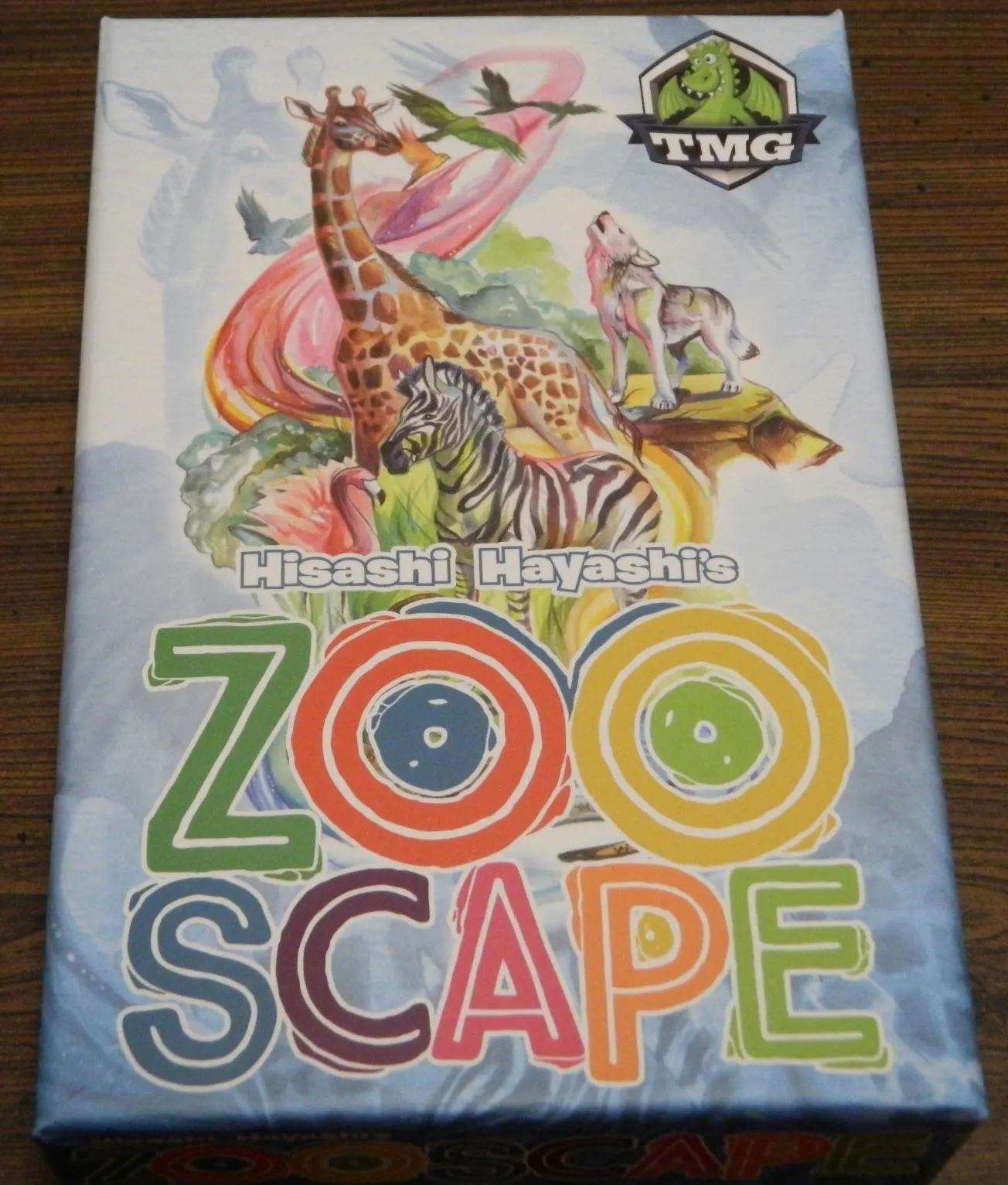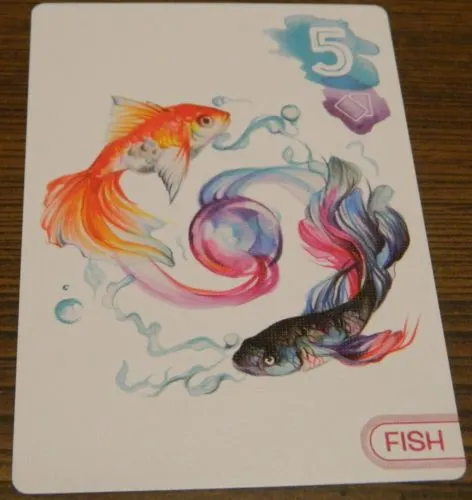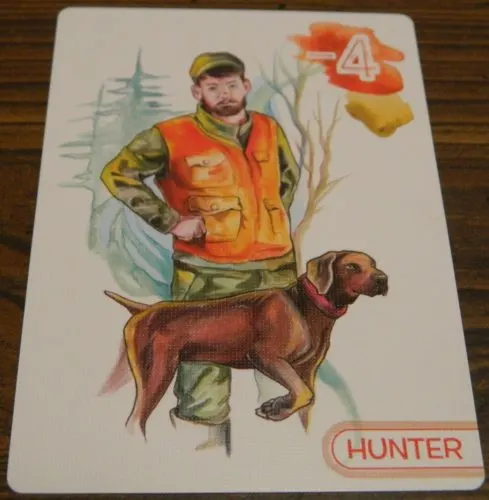I have played a lot of different board games over the years as I am closing in on reviewing 900 different board games here on Geeky Hobbies. Between all of those games I have played a lot of different genres. Of all of the different genres that I have played I would say that set collecting is one of my favorites. I have played a lot of different set collecting games over the years and yet I don’t remember playing one quite like today’s game Zooscape. In addition to set collecting Zooscape uses a game mechanic that most people refer to as “I cut, you choose”. Even though I don’t ever remember playing a game utilizing this type of mechanic I thought it sounded interesting. Zooscape is a fun and quick little set collecting game that while not perfect should appeal to fans of the genre.
How to Play Zooscape
Setup
- Separate the Fish cards from the rest of the cards. These cards will be placed in a stack on the table.
- Each player takes a “First” and “Second” Zookeeper card. The extra Zookeeper cards are returned to the box.
- The player that most recently “escaped” from a zoo will be given the Zoo Manager, Clipboard, and Zoo Gate card.
- The rest of the cards are shuffled and separated into five decks. These decks will be placed next to one another to form a line. The number of cards in each deck depends on the number of players.
- 3 players: 8 cards
- 4 players: 10 cards
- 5 players: 12 cards
- 6 players: 14 cards
- The cards that weren’t placed into a deck will be returned to the box. Some of these cards may be taken later in the game.
Playing the Game
Zooscape is played over five rounds. For each round you will use one of the decks you formed during setup. Each round will consist of three phases: Splitting the Cards, Chasing Animals, and Cleanup.
Splitting the Cards
To begin this phase the current Zoo Manager (the player with the Zoo Manager card) will take the deck that will be used for this round and lay the cards out in the middle of the table in a line making sure the cards stay in the same order.
The Zoo Manager will then decide how they would like to split the cards into two groups. The player can split the cards however they want, but there must be at least one card in each group. The order of the cards can also not be changed while splitting the cards. When the player has chosen how they want to split the cards they will separate the two groups and place the Zoo Gate card between the two groups.

The Zoo Manager has placed the Zoo Gate card between the snake and chameleon card. Players will get to choose between the four cards on the left or the six cards on the right.
The Zoo Manager will then place the Clipboard card into either group. They can place the card at any point within either group without mixing up the order of the other cards.
Chasing Animals
All of the players (including the Zoo Manager) will analyze the two groups that were formed and decide which group they would prefer. When a player has chosen they will take the Zookeeper card from their hand corresponding to the group that they would like. They will keep their chosen card secret from the other players until everyone has chosen. When everyone has chosen all of the Zookeeper cards will be revealed.
When only one player chooses one of the groups they will get all of the cards from that group which they will place face up in front of themselves. This player will not be able to take any more cards for the rest of the round. If they receive the Zoo Manager card they will split the remaining cards, but won’t get cards from either group.
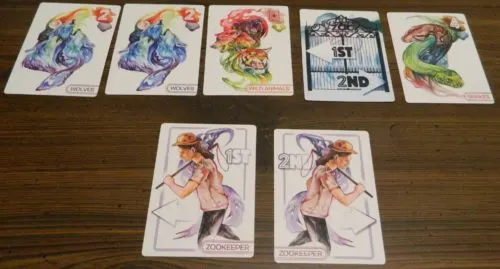
As only one player has voted for both the 1st and 2nd group of cards each player will take their corresponding set of cards.
If none of the players choose one of the groups all of the cards from that group are placed under the Clipboard card. This applies even if a player has already collected the Clipboard card for the round. If the Clipboard card was part of the group that no one selected, it and all of the cards beneath it will be given to the current Zoo Manager who will place it during the next split.
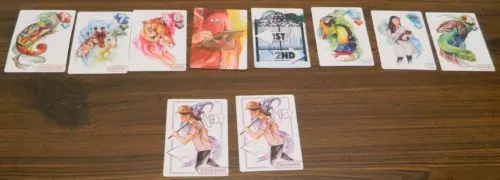
As neither of the players have voted for the second group those three cards will be placed beneath the Clipboard card.
When more than one player chooses a group of cards that group of cards will be split even further. The Zoo Manager card will be passed to the next player to the left. If the current Zoo Manager also has the Clipboard card it and any cards underneath it will also be passed to the next player. The new Zoo Manager will now split the group into two new groups following the process above. If the Zoo Manager was also given the Clipboard card they will get to place it within one of the two groups. All of the players who wanted the group that was just split will now once again choose a Zookeeper card for the group that they now want. This will follow the same process as above. If after a split two of more players choose both groups each of these groups will be handled separately with players only being able to take cards from the group that they originally chose. You will resolve group one first until all of the cards are handled before you move onto group two.
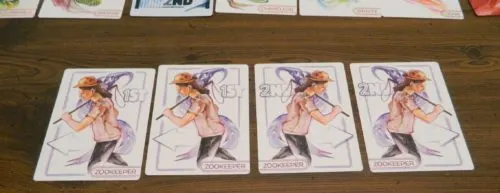
Two players have voted for both the first and second groups. The first group will be split first. After those cards are handled the second group of cards will be handled.
Players will keep splitting the cards and choosing groups until either all of the players have received a group of cards or the cards can no longer be split (there is only one card left). If there are any players that didn’t receive cards during the round they will take a Fish card from the stack on the table. If there are not enough Fish cards left for all of the players that get one, hand them out to the players clockwise from the player that is holding the Zoo Manager card.
Cleanup
After everyone has received cards from the round you will enter the Cleanup phase.
The player who received the Clipboard card during the round will add all of the cards from underneath it to their set of cards. If there are no cards underneath the Clipboard card they will take a Fish card and add it to their cards. They will also be given the Zoo Manager card as they will start the next round.
If no one acquired the Clipboard card during the round all of the cards underneath it will remain with the Clipboard card for the next round. The Zoo Manager card and the Clipboard card will pass to the next player clockwise who will place both at the beginning of the next round.
End of Game and Scoring
The game ends after the fifth round has been played. Players will then tally up points from the cards they collected. Players should separate their cards into groups based on their type. The cards are scored as follows:
Each animal group will be scored separately. All of the animal cards have two pieces of information in the top right corner. The top number indicates how many points each card of that type are potentially worth. The bottom picture indicates the animal’s cage limit (birds don’t have a cage limit).
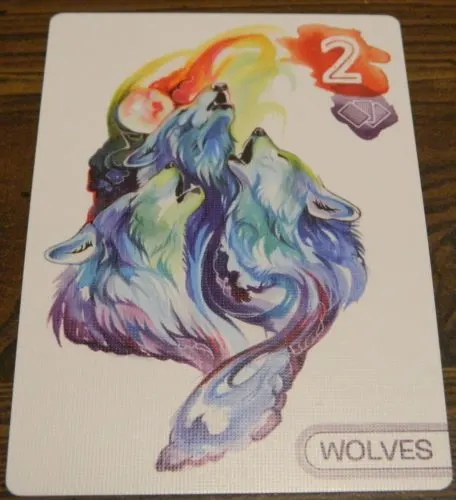
Here is one of the animal cards. For each wolf that a player collects they will score two points. The wolves cage limit is three. If a player collects more than three wolves each wolf will be worth -1 point.
For each animal type you will count up how many of them that you have. If the number is less then or equal to the animal’s cage limit you will score points for each card equal to the animal’s point value. If you have more of the animal than the cage limit you will lose one point for each card of that animal.
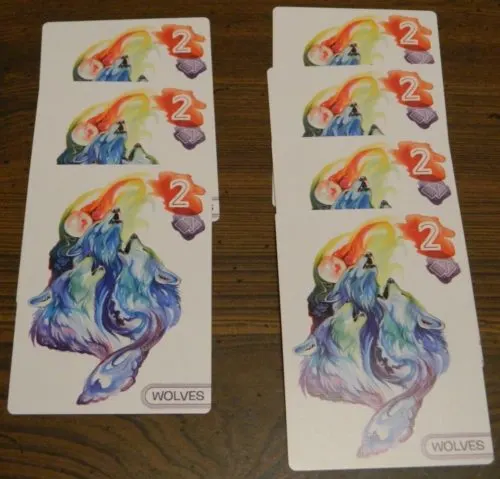
The wolves have a cage limit of three. The player on the left will score two points for each wolf for a total of six points. The player on the right acquired too many wolves so each wolf will be worth negative one point.
Hunter cards are worth negative four points for each card.
When you first acquire a Veterinarian card you must immediately choose two of the animal cards that you have already acquired and discard them. The Veterinarian card is also discarded.
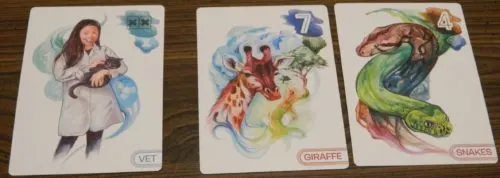
This player has acquired a Veterinarian card so they will have to discard their giraffe and snake card.
When you acquire a Wild Animals card you must immediately draw the top card from the stack of Zoo cards that weren’t added to a deck at the beginning of the game. This card will be added to the rest of your cards and the Wild Animals card will be discarded.
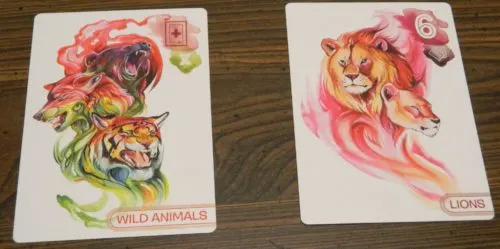
This player acquired the Wild Animals card. They ended up drawing a lions card which they will add to their collection of cards.
When you acquire a Chameleon card it will be become the type of animal that you currently have the most of. If two or more animal types are tied for the type that you have the most of you can choose one of those types to add the Chameleon to. If you have no animals when you acquire the Chameleon you will discard it.
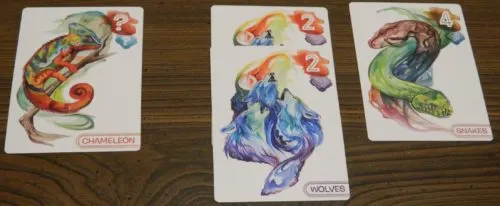
This player has acquired a Chameleon card. As they have two wolves and one snake card the chameleon will become a wolf.
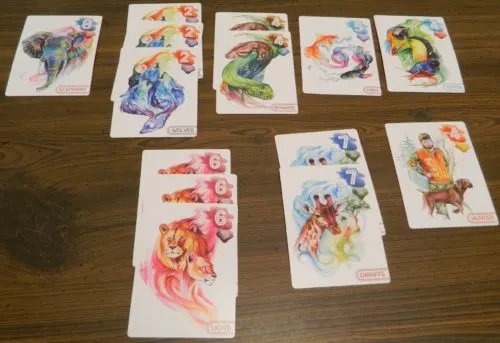
This player has scored positive points from the top row as follows: elephant – 8 points, wolves – 6 points, snakes – 8 points, fish – 5 points, and birds – 4 points. The player will lose three points from the lions and two points from the giraffe because the player has acquired more cards of those types than their cage limits. Finally the player will lose four points from the Hunter card. This player will score a total of 22 points.
My Thoughts on Zooscape
At its core Zooscape is a set collecting game. Like all set collecting games the goal is to gather cards of different sets in order to score points. In most set collecting games you benefit from collecting more cards of the same type as the number of points you score grows exponentially. Things are somewhat different in Zooscape as there are actual limits on each type of card. You ultimately want to collect right up to the type’s limit as it allows you to score more points. You don’t want to go over the limit though or those positive points for each card will turn to negative one.
In many set collecting games you want to collect as many cards as possible as it will allow you to score more points. This is not the case in Zooscape as you need to be selective in what cards you end up taking. Many times you will want to pass up taking more cards in exchange for specific cards that work with the cards that you already hold. There are some rounds where your best action might be to try and only get one card. You need to be picky on what cards you take as one card can turn a set from being worth a lot of points to actually being worth negative points. For example elephants are worth eight points in the game. Getting eight points from card is very good. If you acquire a second elephant card though it goes from being worth eight points to negative two points. Therefore you need to keep track of what cards you already have so you can plan on what cards you want to take each round. In many cases it is better to take less cards than more.
What really differentiates Zooscape from most set collecting games is the mechanic many people refer to as “I cut, you choose” or “pie cutting”. For those of you who have never played one of these type of games before the premise is simple. In each round one player is chosen to cut the cards into two or more groups. Then the other players get to choose which group they would like for themselves. In most games one player cuts the cards and then the other players choose what they want with the cutting player getting stuck with the remainders. This is slightly different in Zooscape as everyone votes on which group they want with the groups being further split based on what groups players vote for.
As I have never played a game like this before I didn’t know exactly what to expect from this mechanic. In general I thought it was pretty good. How the players choose to separate the cards can actually have a pretty big impact on the game. The current Zoo Manager usually has quite a bit of power. When choosing to separate out the cards they are likely going to do it in a way that is beneficial to themselves. They could split the cards where both groups have about the same number of cards or they can skew one group to have considerably more cards. They could try to make one group of cards enticing enough that the other players will choose that one while they choose the other group, or they can make the group they want uninviting to the other players.
This brings me to voting for the group that you want. In some cases it is really obvious which group you should choose as one is either really appealing or the other is unappealing. In many cases though each group has its own positives and negatives. A lot of the strategy in this mechanic comes from trying to read what the other players are going to do. Getting a good grasp on what the other players are going to do gives you an advantage in the game. In some cases you hope to be the only player to vote for a group so you get to take all of the cards. In other situations you want other players to join you in a group so the group gets split further. In either case you need to hope that you read the other players right or it could really hurt you.
In general I wouldn’t say that Zooscape has the most original gameplay, but I still enjoyed it. I think the combination of the set collecting and the cutting mechanic works well together. When choosing which cards to take you actually have to carefully consider what to do. You don’t want to take too few cards leaving points on the table for other players. At the same time you don’t want to take too many cards where your positive points start to turn negative. This leads to an interesting decision for the player cutting the cards as they want to do it in a way where they can try to get the cards for themselves which are the most useful. Zooscape isn’t filled with a ton of strategy, but it has enough for the type of game that it is.
I was actually a little surprised by Zooscape as it was easier than I expected it to be. For a game that has a recommended age of 14+ the game is actually easier than you would expect. The whole cutting mechanic and the limits on how many cards of each type you should collect take a little while to learn for people not familiar with these type of mechanics. This means that it might take players a couple rounds to fully grasp all of the mechanics. The mechanics aren’t difficult though where once you grasp the concept of the game it is really easy to play. I honestly think the game could be played by children under 14 without too many troubles. This allows the game to be played pretty quickly unless the players suffer from analysis paralysis. I think most games should take around 15-30 minutes making it a good filler game.
While Zooscape has a decent amount of strategy, it does rely on a quite a bit of luck as well. Most of the luck comes from how the cards are shuffled to begin the game. As the cards can’t be re-arranged once they are separated into the different decks in some ways your fate is determined to a degree once the cards have been shuffled. Unless you cheat and look at the cards for future rounds you have no idea what cards are going to come out or in what order. The order of the cards for a round is naturally going to benefit some players more than others. There could be a round where you can’t use any of the cards or the cards you want are next to cards you can’t use. Other players might get the perfect order of cards where they get exactly what they want. You can somewhat manipulate the cards based on how they are cut and how you vote, but you also need to hope that the cards are dealt out in an order that benefits you.
I would say that one of Zooscape’s biggest issues comes from the Clipboard card. This problem doesn’t seem to impact a lot of games, but when it does it becomes a big issue for the game. Basically in the game any cards that players don’t choose are put underneath the clipboard. In many cases this will only be a few cards so it can be a good thing for the player that gets the card. This is how the card is supposed to work, but that is not always the case. I am not exactly sure how it happened, but in one game during the second or third round a bunch of cards were added to the clipboard. As no one wanted these cards all of the players avoided the clipboard. These cards rolled over to the next round where even more cards were added to it. After like two rounds it had so many cards under it that no one was going to touch it as it would guarantee that you would lose a lot of points. This hurt the last couple of rounds as players actively chose groups of cards where they wouldn’t get any cards just to avoid taking the Clipboard card. It made player’s choices really obvious as you could tell that they were going to avoid the clipboard which made players choose the same groups even more. I am guessing that this isn’t going to happen often, but when it does it kind of ruins the game.
As for the Zooscape’s theme and components there are things that I liked and others that I think could have been better. On the positive side I thought the components were quite good. The game only comes with cards but I thought they were of a pretty good quality. The cards are pretty thick where they should last if you take care of them. The card artwork is also really good as they use a watercolor style that looks really nice. The quantity of cards is also good where unless you play with the max player count you will have a decent amount of cards that you won’t even use each game. I think the game’s components do a good job supporting the game’s overall zoo/animal theme. In theory I liked the game’s theme.
The main problem with Zooscape’s theme is the fact that it makes little sense with the actual gameplay. The basic theme is that you are a zookeeper at a zoo where the animals have escaped and you have to get them back into their cages. In theory this doesn’t sound too bad as it could make for a good game. The gameplay of separating out the animals and choosing groups makes no sense though. Then you get into individual cards and their special abilities. For example why in the world is there a hunter at the zoo? Even worse is the fact that the Veterinarian gets rid of animal cards. Is she killing the animals? When you know the game’s history some of these quirks start to make a little more sense. Zooscape is actually a re-themed version of two other games that predate it. The game began as Curio Collectors where you collected antiques. Another version of the game is Kimono. While the animal theme makes some sense in some areas, it just doesn’t translate to all elements of the game.
Should You Buy Zooscape?
Zooscape is not a perfect game, but I enjoyed playing it. The game is a combination of a set collecting game mixed with a cutting mechanic. Most of the gameplay revolves around collecting different animals in order to score points. You don’t want to collect too many animals of each type though or they start to be worth negative points. This is combined with a mechanic where one player splits the cards into two groups and all of the players vote for which group of cards that they want. These two mechanics work well together as you need to guess what you think the other players are going to want while also only taking cards that you really need. Some of the mechanics take a while to get used to, but I thought the game was pretty easy for the most part. Zooscape has a decent amount of strategy as your decisions make a difference in the game. The game still relies on quite a bit of luck though. This can made even worse as the clipboard can sometimes get stuffed with cards that players don’t want.
My recommendation for Zooscape comes down to your feelings towards set collecting games and the game’s overall premise. If you generally don’t like set collecting games or don’t think the game sounds all that interesting it probably won’t be for you. People who think the game sounds interesting though should enjoy it and consider picking it up if they can get a good deal on it.
Buy Zooscape online: Amazon (Zooscape, Kimono
), eBay (Zooscape,
Curio Collectors,
Kimono
)

